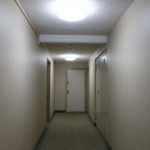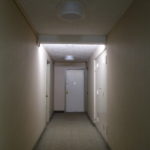When better to embrace the ability of smart lighting to change the emotional tone of the environment than the holiday that thrives on raised tension… Halloween? Last year we used a Philips Hue and the Hue application to change the hallway in front of the Architechnologist‘s office… remember Smart Lighting Sets a Scary Hue (October 29, 2015)?
 This year we have used some of the new devices in the Hue system to take it up a notch and automate the whole thing – and we’re going to share how we did it, step-by-step. Our hallway is banal at best and features LED light fixtures.
This year we have used some of the new devices in the Hue system to take it up a notch and automate the whole thing – and we’re going to share how we did it, step-by-step. Our hallway is banal at best and features LED light fixtures.
 This year, all the lighting will come from a Philips Hue Lightstrip Plus (Amazon link) that we mounted at the ceiling behind an existing beam. The Lightstrip has the same tremendous range of colors available as the Philips Hue bulb we used last year, but it does not require a fixture and provides a better wash of light. If we had a larger hallway (or a suburban front porch), we could have made the whole scene change color by adding one (or more) Philips Hue Lightstrip Plus Extensions and increased our lighting up to 33 feet (Amazon link). After blocking the light from the building’s LED fixtures, we tested the Lightstrip Plus…
This year, all the lighting will come from a Philips Hue Lightstrip Plus (Amazon link) that we mounted at the ceiling behind an existing beam. The Lightstrip has the same tremendous range of colors available as the Philips Hue bulb we used last year, but it does not require a fixture and provides a better wash of light. If we had a larger hallway (or a suburban front porch), we could have made the whole scene change color by adding one (or more) Philips Hue Lightstrip Plus Extensions and increased our lighting up to 33 feet (Amazon link). After blocking the light from the building’s LED fixtures, we tested the Lightstrip Plus…

Image Credit: The Architechnologist
Instead of using a tap on the Hue application to flood the hallway with red light (as we did in 2015), this year we put the new Philips Hue Motion Sensor (Amazon link) to work in the hallway. We introduced the motion sensor last month (Even Smarter Lighting From Philips Hue, September 27, 2016) and finally got to try it with this installation. Adding the motion sensor to the Hue system and getting it to do exactly what we wanted was simple and the result was perfect.
You still have some time to get your own home haunted… What high-tech tricks (or treats) do you use to decorate your place?
